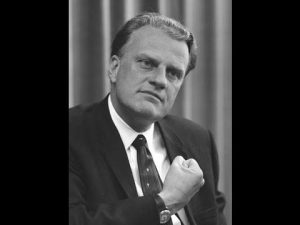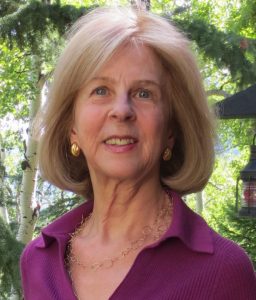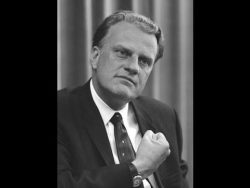The Kingdom And The Powah
The conversion of Elaine Pagels
When I first heard Billy Graham, on the radio, I felt related. He spoke like my father’s family from the mountains north of Asheville, NC. He would say heah for here. and continya for continue. I never saw him in person, but his full voice and clear phrasing rode the radio waves to my room. I turned away from my high school homework to hear about the choice I must make (but never did).
Those were the prosperous postwar years, and, “With President Eisenhower he (Graham) helped forge a connection between religion and patriotism designed to unite Americans against communism,” in the words of Frances Fitzgerald in The Evangelicals (2017). The national Christian consensus condemned communism as “godless.” This was a powerful indictment, based on Lenin and discarding the fact that Stalin brought back the Orthodox church.
 Graham was not close to Eisenhower, but he formed a lifetime friendship with Nixon, then vice president. He visited Kennedy, and after the assassination formed an alliance with Johnson, who invited him to the White House so often that Graham called it his Washington hotel. He offered his counsel to every subsequent president ending it in his nineties with Obama. The historian Fitzgerald does not discuss the issue of separation of church and state implied by the influence and official respect given a beloved Baptist evangelist. Graham himself answered, “The framers of our Constitution meant we were to have freedom of religion, not freedom from religion.”
Graham was not close to Eisenhower, but he formed a lifetime friendship with Nixon, then vice president. He visited Kennedy, and after the assassination formed an alliance with Johnson, who invited him to the White House so often that Graham called it his Washington hotel. He offered his counsel to every subsequent president ending it in his nineties with Obama. The historian Fitzgerald does not discuss the issue of separation of church and state implied by the influence and official respect given a beloved Baptist evangelist. Graham himself answered, “The framers of our Constitution meant we were to have freedom of religion, not freedom from religion.”
He supported Johnson’s escalation of the war in Vietnam, saying, “Communism has to be stopped somewhere.” He toured south Vietnam as the guest of Gen. Westmoreland. On civil rights, Graham was guarded. He desegregated his crusades in the late 1950’s but never held one in the Deep South. He said, “The great answer to our racial problem in America is for men and women to be converted to Christ.” To which Fitzgerald comments, “as if the South were not peopled with born-again Christians.”
Fitzgerald excludes Black ministers from her history, and this might simply reflect the cultural differences between religious practices of the two races in America, even outside the South. My daughter and I attended a Memphis megachurch with video feeds from Houston one Sunday. In the taxi afterwards I told the Black driver we had been to church. “Black or white?” he asked. “Both,” I said, meaning it was a mixed congregation. His response was a big, “Umhumm.”
The theologian Reinhold Niebuhr of Union Theological Seminary called upon Graham to make his converts feel that their Christian duty entailed actively working toward the end of segregation and racial discrimination. “But this Graham would never do,” Fitzgerald writes. Niebuhr, given op-ed space by the New York Times just before Graham’s first Crusade for Christ at Madison Square Garden, said his “bland” evangelism “promises a new life, not through painful religious experience but merely by signing a decision card.”
Niebuhr minimized what hundreds of thousands were experiencing. Graham’s call came at the end of a sermons that built in intensity as he quoted scripture, bible in hand. His delivery was flawless. It was personal. You must make a choice and make it now. They poured down from the bleachers in packed sports arenas or stadiums. They came forward as his choir sang angelically.
At the San Francisco Cow Palace in 1958, one who answered Billy Graham’s call was a 15-year-old girl from Palo Alto, where her father was a Stanford physics professor. Elaine Pagels, who would become a leading scholar of early Christianity, publishing at least one best seller, begins her 2018 memoir, Why Religion?, with a recollection of that intense teenage experience.
She recalls that the preacher began to speak, “quietly at first, warning that what he’d say would sound foolish and irrational to intellectuals and university professors — the authorities in the world I lived in — and it did.” He excoriated America for “driving its most brilliant sons to invent ever-more-horrific nuclear weapons. I was startled, having been taught to admire science as the source of all wisdom, and America as the world’s standard of what was right.”
She walked forward, “moved by his passionate conviction, and overcome by tears,” and it changed her life — for a few years before Stanford and Harvard Divinity. “Born again,” she broke from her horrified family. She took up with a group of artistic young people (including guitarist Jerry Garcia), but everything collapsed when her boyfriend was killed in a car crash. It was only the first of the profound losses that have informed her life and religious experience.
Among her remarkable findings in a life of contemplation and scholarship:
— Inspired by her friendship with contemplative monks, she concluded that “while the Buddha declared as his first noble truth that ‘all life is suffering,’ Jewish and Cristian theologians, on the contrary, speak of ‘the problem of suffering,’ as if suffering and death were not intrinsic elements of nature but alien intruders on an originally perfect creation. . . .So we are stuck with this problem, and left with no answers.” She co-teaches a course in Buddhism at Princeton.
— She was surprised to discover in from her study of sacred texts that “Satan does not appear in the Hebrew Bible — not, at least, as Christians and Muslims know him, as an evil supernatural power.” In Genesis the serpent is only “a cunning, talking snake, perhaps a stand-in for the humans’ inner voice.” So Satan is a Christian creation in respomse to the problem of evil in the world of a loving God.
— From her translations of the repressed “Gnostic Gospels,” left out of the New Testament, she learned of a feminine divinity. In The Secret Revelation of John, one of the scrolls found in the Egyptian desert, Jesus appears to him saying, “I am the Father; I am the Mother; and I am the Son!” So the Gnostic Trinity would be: Father, Mother, and Holy Spirit.
 “What these sources do show is that many people in antiquity spend enormous time and energy searching for ways to ‘heal the heart,’ as countless people are doing today, expanding an enormously increased range of chemical medications, therapeutic techniques, exercises, and support groups as well as practices of meditation and yoga. And while my own plunge into the history of religion began after that first explosive experience with evangelical Christianity, what happened during our son’s illness and death, followed so soon afterward by my husband’s death, compelled me to search for healing beyond anything I’d ever imagined.”
“What these sources do show is that many people in antiquity spend enormous time and energy searching for ways to ‘heal the heart,’ as countless people are doing today, expanding an enormously increased range of chemical medications, therapeutic techniques, exercises, and support groups as well as practices of meditation and yoga. And while my own plunge into the history of religion began after that first explosive experience with evangelical Christianity, what happened during our son’s illness and death, followed so soon afterward by my husband’s death, compelled me to search for healing beyond anything I’d ever imagined.”
In an homage to one of the Egyptian scrolls called The Gospel of Truth she says, it “is about not intellectual knowledge, but knowledge of the heart. What first we must come to know is that we cannot fully know God, since that Source far transcends our understanding. But what we can know is that we’re intimately connected with that divine Source since (quoting the translation) “in him we live and move and have our being.”


Thanks for your contemplations during the Pandemic. I much enjoyed them.
I’ve read a couple of Elaine Pagels’ books. One was ‘The Origin of Satan’, which I recommended when I was working at a bookstore out at LAX. Customers didn’t buy the book most likely because the provocative title or maybe they thought it was a book about ‘Satanism’ but quite the contrary! It’s a book about what Satan meant to early Christianity and how the concept of evil was used to demonize those who opposed the new religion. The early church utilized brilliant [and brutal] PR setting up the church and labeling anything non-Christian as evil or wrong. But one intriguing concept of how Satan was presented [if I recall correctly] was by the Gnostics who viewed Satan not as evil but as a guide to make people choose the right path. So, for instance, Satan would perhaps block your way along a road you were taking, thus forcing you to go a different [correct] direction. So, in this way, Satan was not evil but a guide telling you which way NOT to go. I’m not sure this all ties into your post but perhaps the various philosophical paths we take in life are the contrary paths that seem the better choice when the obvious paths get blocked by some undefined thing looking out for our best interests. Thanks, Larry.
Re: Billy Graham. While pounding the beat as a TV reporter in Albuquerque I had the occasion to meet The Reverend Billy Graham. It was during his crusade visit to the infamous “Pit” – the University of New Mexico basketball arena. I don’t recall how many nights the performance occurred, but it was something. A TV production of the highest quality. The giant choir of numerous local congregations filled one side of the arena. The rest of the seats filled with people there to be saved, curious onlookers, or just folks who wanted to be part of the spectacle – including, most probably, George Beverley Shea singing of How Great Thou Art. Hundreds came forth during the call at the end of the performance. I wander. My assignment that day was to interview Dr. Graham – which he kindly agreed to do. Media, and TV in particular, was his friend. I don’t recall the questions, nor the answers…but I do remember one thing. His dressing room was, in reality, one of the basketball team dressing rooms – with a wall of curtains in place to hide the lockers. And, I know not what, but there was “something else” or “someone else” in that room besides Billy Graham and my TV photographer. Maybe it was just the aura of this world famous evangelist …or, maybe it was something or someone else… God only knows! I recall a very humble man. Not so much I’m told about son, Franklin. Franklin was in town this year and had a one-night stand at Expo New Mexico – the state fairgrounds. The production, again top rate. Observers said Franklin Graham “arrived” in a flurry of activity, rolling in a big white SUV limousine – wearing a white suit. Different times, indeed!
Thank you, Rodger, for this report reminiscent of yr work in those old days. Observant, economical, subtle.